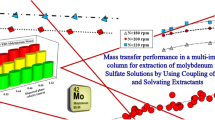Abstract
Aqueous two-phase systems (ATPSs) have long been used for biomolecule partitioning; these systems offer the possibility of using continuous or semicontinuous extraction processes. They require relatively simple equipment like spray or sieve plate columns that can be adapted for use in ATPSs. The aim of this work was to study the semicontinuous extraction of a model enzyme, xylanase, in spray and sieve plate columns, since, unlike centrifugal contactors, the cost of construction and maintenance of this equipment is low and it is easy to operate. For the spray column, the dispersed phase hold-up and overall mass transfer coefficients K D a were evaluated for different column heights and for different superficial velocities of the dispersed phase (light phase). Results indicated that an increase in superficial velocity in the range of 0–0.18 mm/s of the dispersed phase had a positive effect on K D a and on hold-up in all column heights studied, 75, 161 and 246 mm. For the same superficial velocity of the dispersed phase, the larger the hold-up was, the shorter the column. For the sieve plate column, the effects of the superficial velocity of the dispersed phase and the number of plates were also studied. Results showed that the K D a and hold-up increased with an increase in both parameters. The selectivity of separation of xylanase and BSA (model contaminant) was very high, since 60% of the enzyme was extracted in the light phase, whereas no significant amount of BSA was extracted. The possibility of using the sieve plate column in continuous operation for enzyme extraction was studied because previous work had only addressed the semicontinuous extraction of enzyme. The residence time distribution of the PEG phase using different superficial velocities of the salt phase was studied in continuous operation. The time required to reach the steady state was 40 min, and 70% of the xylanase was recovered. It was found that the Modified Power Spline software was well adjusted to the experimental results.








Similar content being viewed by others
Abbreviations
- L salt :
-
volumetric superficial velocity of salt phase (m3/s)
- L PEG :
-
volumetric superficial velocity of PEG phase (m3/s)
- V d :
-
volume of dispersion (m3)
- m :
-
partition coefficient of the solute
- C :
-
concentration of the solute
- salt:
-
salt phase
- PEG:
-
PEG phase
- i:
-
inlet
- o:
-
outlet
References
Cunha T, Barros RA (2000) Large-scale extraction. In: Kaul RH (ed) Aqueous two-phase systems. Humana, Lund, Sweden, pp 391–409
Greve A, Kula MR (1991) Recycling of salt from the primary bottom phase of a protein extraction process. J Chem Technol Biotechnol 50:27–42
Sawant SB, Sikdar SK (1990) Hydrodynamics and mass transfer in two-phase aqueous extraction using spray columns. Biotechnol Bioeng 36:109–115
Jafarabad KR, Sawant SB, Joshi JB (1992) Enzyme and protein mass transfer coefficient in aqueous two-phase systems. 1. Spray extraction columns. Chem Eng Sci 1:57–68
Hamidi A, van Berlo M, Luyben KC, van der Wielen LAM (1999) Flooding characteristics of aqueous two-phase systems in a countercurrent sieve-plate column. J Chem Technol Biotechnol 74:244–249
Bhawsar PCM, Pandit AB, Sawant SB, Joshi JB (1994) Enzyme mass transfer coefficient in a sieve plate extraction column. Chem Eng J 55:B1–B17
Bim MA, Franco TT (2000) Extraction in aqueous phase systems of alkaline xylanase produced by Bacillus pumilus and its application in kraft pulp bleaching. J Chromatogr B 743:349–356
Nunhez JR, Mori M, D’Ávila SG (1993) Fitting thermodynamic data using the modified spline technique. Comp Chem Eng UK 17:1091–1099
Snyder SM, Cole KD, Szlag DC (1992) Phase compositions, viscosities, and densities for aqueous two-phase systems composed of polyethylene glycol and various salts at 25°C. J Chem Eng Data 37:268–274
Franco TT, Andrews JA, Asenjo, JA (1996) Conservative chemical modification of proteins to study the effects of a single protein property on partitioning in aqueous two-phase systems. Biotechnol Bioeng 49:300–308
Bailey MJ, Biely P, Poutanen K (1992) Interlaboratory testing of methods for assay of xylanase activity. J Biotechnol 23:257–270
Miller GL (1959) Use of dinitrosalicylic acid reagent for determination of reducing sugar. Anal Chem 31:426–428
Sedmak JJ, Grossberg SE (1977) A rapid, sensitive and versatile assay for protein using Coomassie Brilliant Blue G250. Anal Biochem 36:544–552
Levenspiel O (1962) Chemical reaction engineering: an introduction to the design of chemical reactors. Wiley, New York
Venancio A, Teixeira JA (1995) Protein mass transfer studies on a spray column using PEG-Reppal PES 100 aqueous two-phase system. Bioprocess Eng 13:251–255
Acknowledgements
The authors would like to thank the Brazilian development agencies Fapesp (Proc. 99/11690-9) and CNPq and Novo Nordisk (Ponta Grossa, Paraná, Brazil) for the donation of xylanase and Dr. Jose Roberto Nunhez (School of Chemical Engineering, Unicamp) for his collaboration with the Modified Power Spline computational software.
Author information
Authors and Affiliations
Corresponding author
Rights and permissions
About this article
Cite this article
Igarashi, L., Kieckbusch, T.G. & Franco, T.T. Xylanase mass transfer studies in aqueous two-phase systems using spray and sieve plate columns. Bioprocess Biosyst Eng 26, 151–157 (2004). https://doi.org/10.1007/s00449-003-0329-x
Received:
Accepted:
Published:
Issue Date:
DOI: https://doi.org/10.1007/s00449-003-0329-x




